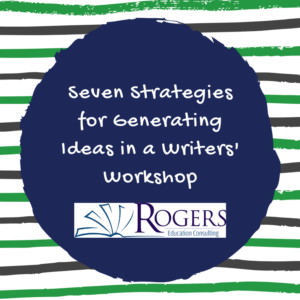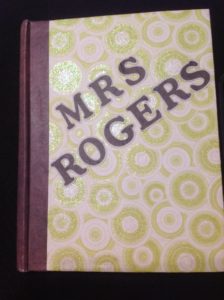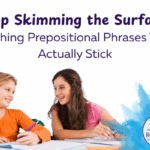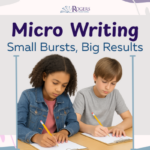 In the ideal Writers’ Workshop, students will write about topics of their choice that they are passionate about. This sometimes leads to frustration on the part of the students because they have a hard time figuring out what they want to write about and many times we hear comments like “I have nothing to write about miss.”, “Nothing ever happens to me.”, etc. It is our job, as educators, to guide students and assist them in realizing they do have stories to tell.
In the ideal Writers’ Workshop, students will write about topics of their choice that they are passionate about. This sometimes leads to frustration on the part of the students because they have a hard time figuring out what they want to write about and many times we hear comments like “I have nothing to write about miss.”, “Nothing ever happens to me.”, etc. It is our job, as educators, to guide students and assist them in realizing they do have stories to tell.
 At the beginning of the year, I start by letting students decorate their own composition book for Writers’ Workshop. This notebook will be a place where they gather their ideas so that they always have a running list and a place for them to draft and write. I will help students, about once a month, do some kind of generating idea activity. That way, when we’re writing and they tell me they have absolutely nothing to write, I can open their notebook with them and suggest some of the ideas they have brainstormed.
At the beginning of the year, I start by letting students decorate their own composition book for Writers’ Workshop. This notebook will be a place where they gather their ideas so that they always have a running list and a place for them to draft and write. I will help students, about once a month, do some kind of generating idea activity. That way, when we’re writing and they tell me they have absolutely nothing to write, I can open their notebook with them and suggest some of the ideas they have brainstormed.
Here are a few ways to generate ideas in your classroom:
- Mentor Texts
- Mentor texts are any piece of literature that is used as a model for students to emulate in their own writing. Mentor texts for generating ideas would be texts used to get students thinking of text-to-self connections, and more specifically, their own personal stories that are sparked by the text. One example is my lesson here using Wilfred Gordon McDonald Partridge by Mem Fox. Here is another lesson using Nothing Ever Happens at the South Pole by Stan Berenstain.
- Choose a text you believe the students will connect to in some way and read it aloud. Let students talk in small groups about how they connect to the story. Then you can ask them a specific question that connects them to the text on a different level. For example, you might ask; “Have you ever had a hard time meeting new people?”
- For a great list of picture books, I like to use, check out this live document. Just click the tab at the top that says “generating ideas”.
- Conversation Starters

- Let’s face it, kids like to talk. Writing is a social process, so let’s not fight the system! Come up with a list of questions and prompts to get kids thinking and talking. Print them out and put a handful of them at a table group and ask each student to choose one. Students will read the question (If you could design the playground, what would it look like? If you could have dinner with anyone, who would you choose? etc.) and ponder it quietly by themselves for a couple of minutes. Then give each person 1 -2 minutes to share their question and response among their tablemates.
- Next, have students open their writing journals to jot down stories they could write about later. Maybe they liked their own question and have future story ideas or maybe someone else in their group had a question that resonated more with them. They can jot down any ideas that popped into their heads.
- If you want conversation starters already created, check this out!
- Heart Maps
- Georgia Heard brought the concept of heart maps to Writers’ Workshop for generating ideas. I love the concept because our best writing will come from passion. So why not have students generate ideas that are close to their heart? These, after all, will be their best-told stories. Here is information to get started.
- Listing Possible Topics
- Choose 2 – 3 topics and model for students how to generate ideas in the topic area and then allow them time to do the same. You can have students list favorites (books, movies, teachers, etc.) or times when they felt certain ways (embarrassed, happy, etc.)
- Here is a list of suggested topics. This is how I have used this strategy with a middle-school class.
- This or That

- Present students with two ideas. Give them a minute to think about them. Then they write one of the two ideas at the top of their journal page. Set the timer for 2 minutes and students must write on the topic they chose. They can list ideas that follow the topic, tell a story, write how they feel, etc. At the end of the two minutes, they should share some of their ideas and see if anything would make a good story later on. If students have something there, they can highlight it. I have them do two or three of these in one warm-up slot. Here are three I have used in the past.
- Rolling the Dice
- What kid (or adult!) doesn’t like rolling dice? So, I capitalized on the novelty and purchased alphabet dice from Amazon. Have student groups roll the die. Whatever letter shows up, students write a list of stories they have that begin with that letter. They will list out random letters, but when I did this with students, one student’s most favorite story he wrote that year was about how he detested hats. He rolled an H and couldn’t think of anything so he wrote hats. Then he began to think that he hated hats. He wrote two pages on why hats are awful.
- Love it or Loathe it! (Source: Marvelous Mini Lessons)
- As I’ve said before, the most powerful writing comes from things you are passionate about, either positive OR negative passion. So, have students create a T-chart and write “Love It” on one side and “Loathe It” on the other. Next have students generate a list of things they love and things they detest. Then they can write a story on anything they list.
- When I model this for the students, on the “Loathe It” side, I always write how I loathe green bell peppers. I share with them that the smell alone is revolting. I explain how I refuse to let green bell peppers enter my house and I can’t even eat food that has had green bell peppers in it, even if they’ve been picked out, because the smell and taste permeate through the entire dish! By this point, they are all laughing, but they see how something as simple as not liking a food can make the best story.
How do you get students to generate ideas for Writers’ Workshop?


